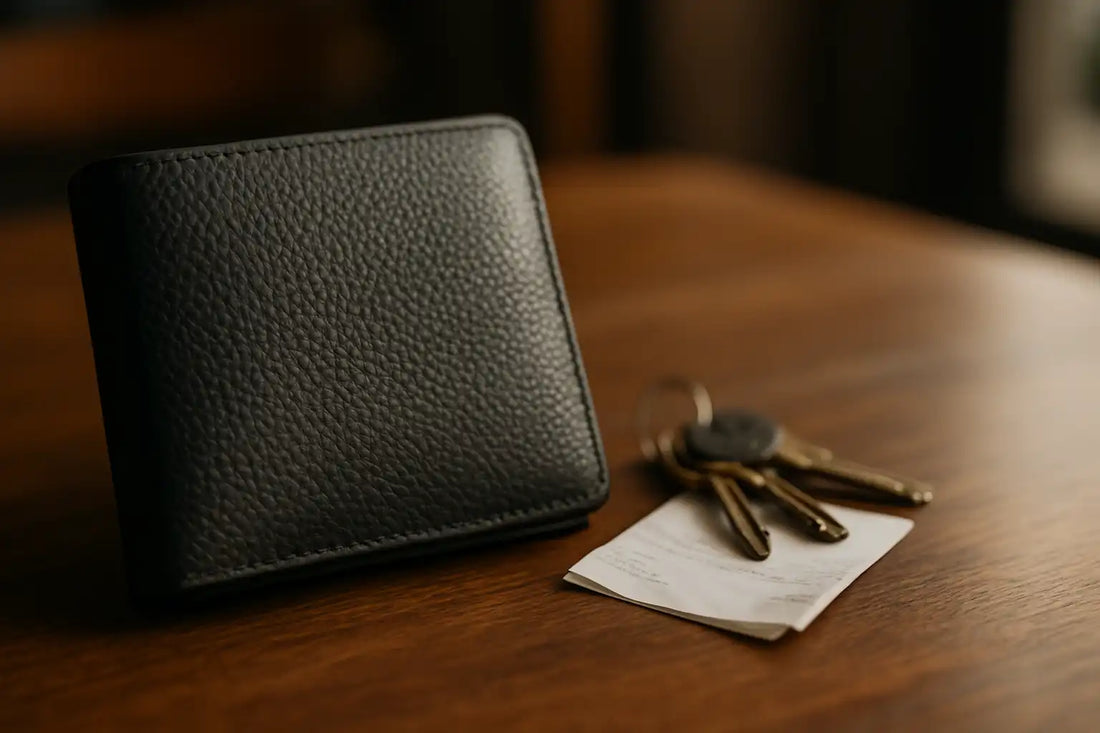
What is Crossgrain Leather?
Share
I once panic-bought a wallet because my old one looked like it had survived a dog fight. This new one had a strange little bumpy surface, neat as a row of cobblestones. I thought it looked posh. Ten years later, it still looks fresh, unlike the trousers around it.
When I asked Vas, my long-suffering cobbler, he grunted: “Crossgrain. Tough as nails.” Then he went back to fitting steel blakies on my Dune boots, muttering under his breath.
So here’s the truth about this quiet workhorse of the leather world, with a little help from science.
What is crossgrain leather?
Crossgrain leather is real hide embossed with a pebble-like pattern using heat and pressure, making it durable, uniform and scuff-resistant. You’ll often find it on wallets, handbags, organisers and belts — anything that takes daily punishment but is still expected to look smart.
The grain isn’t usually natural; it’s pressed in with machinery. That’s why it looks suspiciously perfect (see also Embossed Leather).
How is crossgrain leather made?
Tanneries soften the hide, then use heated plates to press the grain into place. Pigments or coatings are sometimes added first for extra neatness.
According to Nasr (2017) in Influence of some mechanical finishing processes on manufactured leather properties, embossing and coating make leather more resistant to water spotting. But, if overdone, these finishes can reduce tear strength. So crossgrain’s strength depends on careful processing.
Advantages of crossgrain leather
The big pluses: strength, low fuss and uniform looks.
-
Durability: Hides 5–6 minor scratches that would ruin smooth calf.
-
Easy care: Dirt stays on the surface and wipes away.
-
Consistent panels: Luxury brands love it for small leather goods.
Backing this, Meyer et al. (2021), in Comparison of the Technical Performance of Leather, Artificial Leather and Trendy Alternatives found tight-grained leathers outperform synthetics in mechanical strength.
Disadvantages of crossgrain leather
The downsides: slower character, colour shifts and less breathability.
-
Slow patina: Expect a gentle shine, not dramatic marbling like Crazy Horse Leather.
-
Colour changes: Omur et al. (2025), in Influence of embossing parameters on colour changes and shape retention behaviour of vegetable-tanned leathers, found high-temperature embossing boosts shape retention but causes stronger colour shifts.
-
Variable quality: Even cheap splits can be embossed and sold as “crossgrain.”
-
Breathability: Meyer (2021) noted compact grains reduce moisture permeability, making them less “breathable” than open-pored hides.
Fun facts about crossgrain
-
Luxury houses favour it because customers want “new” for years, not “aged in months.”
-
Its bumpy surface disguises dirt and stains better than smooth nappa.
-
Research confirms embossed leather resists water better than nubuck (Nasr 2017).
-
Don’t dry it on a radiator unless you enjoy 3–4 nasty cracks. (I did it once. Vas laughed for a week.)
Caring for crossgrain leather
Wipe, feed lightly, waterproof. My Sunday routine:
-
A quick wipe with a damp cloth.
-
I applied a pea-sized dab of Saphir Creme Universelle Leather Balm.
-
If the weather is grim, apply a thin layer of Collonil Leather Gel 60ml Classic.
Patch-test first. And skip baby wipes. I tried it once and my belt stayed sticky for two days. Even Vas cracked a smile, which is rarer than sunshine in February.
FAQs
Is crossgrain leather real leather?
Yes. The term describes the finish, not the species or quality.
Does it crack less than smooth leather?
Usually, yes. The finish distributes stress, but over-embossing (Nasr 2017) can reduce tear strength.
Does it patina?
Yes, slowly. Shine and corner darkening after a year, but no wild shifts. If you want drama, try Vegetable Tanned Leather.
What’s the best way to clean a spill?
Blot gently, wipe with a damp cloth, then balm. Finish with Collonil Gel before going out.
